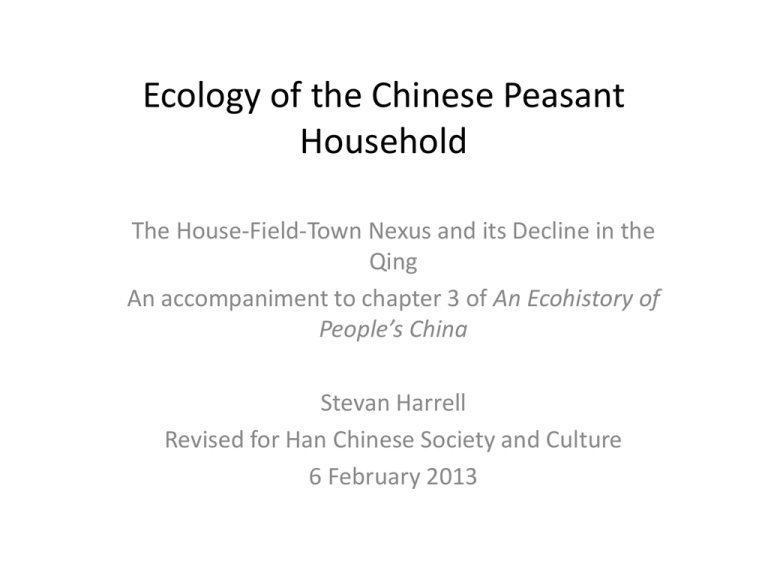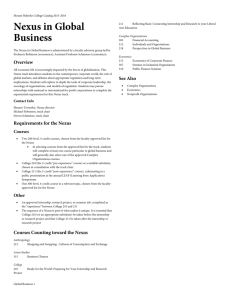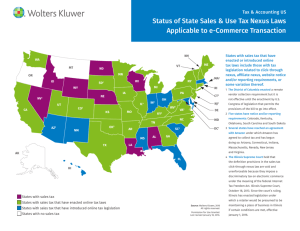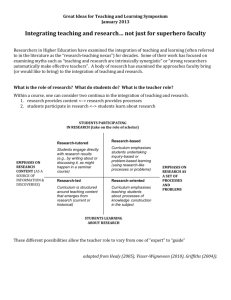further explication
advertisement

Ecology of the Chinese Peasant Household The House-Field-Town Nexus and its Decline in the Qing An accompaniment to chapter 3 of An Ecohistory of People’s China Stevan Harrell Revised for Han Chinese Society and Culture 6 February 2013 Historical Frequency of Floods and Droughts in the Wei River Plain Source, Yin Shuyan et al., Historical Drought and Water disasters in the Weihe Plain. Acta Geographica Sinica 15(1):197-205, 2005. Qing—Disturbance and slow variables Qing slow variables: Population growth (Oct 5) Agricultural extension and Intensification (Oct 10) Increased water capture (Oct 12) The house-field-town nexus and the decline in its resilience (today, October 24) Qing--Hysteresis Qing Hystereses: Eroded lands Altered watercourses Overtaxed institutions (today we concentrate on household level) Waterworks as illustration of the curvilinear relationship between productivity/intensification and resilience ResIience Start with irregular rainfall Build a reservoir Reservoir contains excess in big storms Reservoir retains water in droughts Natural events don’t become disasters Harvests become more reliable Resilience varies directly with productivity Resilience varies inversely with productivity Productivity Reclaim more land Reservoir can’t release water, exceeds capacity Community more dependent on lands that will flood Natural events become disasters The Household Developmental Cycle Nuclear Stem Joint Nuclear The House-Field-Town Nexus Affines’ Village House Village Town Forest and Pasture Fields Household’s Own Field Figure 3-3 Flows of Household Goods and Services Solid arrows are private goods Dashed arrows are common pool goods Importance of flows is roughly proportional to weights of arrows. The house-field-town nexus The house-field-town nexus: materials and ventilation placements of nianhua (Diagram by Andrew Whiteman The house-field-town nexus: House plans and spirits The most prevalent kind of nianhua produced by both the Chen and Li families in Mianzhu is the military door-god. The Chens produce over ten different pairs of military guardian deity pictures, each with characteristic dress, headgear, weapons, and pose, and produced as a pair in contrasting colors. These military guardians are used to protect the family as a unit from outside attacks, whether by malevolent spirits or by criminals, so their armaments and their postures are central to their function. They are placed at locations where the family meets the outside: at the front and back gates of the compound, where the private world of the family meets the public world of the street (in front and sometimes in back) or of the fields (usually in back). Figure 9: A pair of military door gods (Photo copyright Burke Musem) Next in line, and also belonging to the broad genre of door gods, are the The house-field-town nexus: House plans and household structure The house-field-town nexus: The Village as an agglomeration of houses with obligations of reciprocity The house-field-town nexus The house-field-town nexus: Private resources The house-field-town nexus: Resource Commons The house-field-town nexus Market Landlords State Buffers or Guarantors • Infrastructure: mostly waterworks • Institutions – Kin groups – Irrigation Associations – Temples • Beliefs and values: See descriptions in Fei, Yang, Leonard, etc. – – – – Frugality Recycling Generational Continuity Within-community Reciprocity • Ecological buffers – – – – Wetlands Forests: Recall Elvin and Marks Fallow land Ungrazed pasture Population Growth in the Qing and PRC 500 450 Million Figure 1b. Messy Situation of Estimates and Guestimates, 1000–1911 McEvedy-Jones's estimates, 1978 Chao's estimates, 1986 Maddison's estimates, 1998 400 Elvin's estimates, 1973 Lavely–Wong's estimates, 1998 350 Lee-Wang's estimates, 1999 Cao's estimates, 2000 300 Perkins' estimates, 1969 Ho's point, 1970 250 Pomeranz's point, 2000 200 150 100 1900 1850 1800 1750 1700 1650 1600 1550 1500 1450 1400 1350 1300 1250 1200 1150 1100 1050 0 1000 50 Time Kent G. Deng, Unveiling China’s true population statistics for the pre-modern era from census data. Population Review 43 (2), 2004 Source: Official censuses based on Liang 1980: 4–11; see also Lu and Teng 2000: Appendix. Estimates: Perkins 1969: Appendix A; Ho 1970; Elvin 1973: 129, 310; McEvedy and Jones 1978: 166–74; Chao 1986: 41; Lavely and Wong 1998; Maddison 1998: 267; Lee and Wang 1999: 28; Cao 2000: 690–772; Pomeranz 2000: 241. Note: Tax regimes: T.T. – Period of the triplex tax regime; D.T. – Dual tax regime; S.T. – Single-track tax regime. www.chinaprofile.com Flows in the house-fieldtown nexus Rough balance Guarantors Infrastructure Institutions Values Eco. buffers (s+r+t)-p=exploitation Within bounds=moral economy Energy Slow variable change in the house-fieldtown nexus Rough balance Guarantors Infrastructure Institutions Values Eco. buffers Energy Depletes Topsoil Forest biomass Ground water Game animals, etc (s+r+t)-p=exploitation New World crops in hilly areas as slow variables Energy Increases Fertility Population Area Planted Depletes Topsoil Forest biomass Wetland reserves Weakens Guarantors Infrastructure Institutions Values Eco. buffers Population explosion as slow variable Energy Increases Fertility Population Area Planted Depletes Topsoil Forest biomass Wetland reserves Weakens guarantors Infrastructure maintenance Adaptability of institutions Summary of Loss of Ecosystem Resilience in the Qing Dynasty INSTITUTIONS INFRASTRUCTURE ECOLOGICAL BUFFERS VALUES Limited adaptation to new environments Reaching capacity in rule-making and adjudication Migration and refugees disturb composition Strain increased More locked in Maintenance deteriorates Wetlands reclaimed Forests converted to grain Pastures grazed more intensely Swidden cycle shortened Desperation leads to re-evaluation of self-interest Value transmission and teaching disrupted Positive Feedback Loops Within the House-Field Axis Need for more land Convert Forest to Arable Flooding Lower Productivity Increased runoff Soil Loss Positive Feedback Loops Within the House-Field Axis Need for more land Reclaim Wetland Lose buffer against storms Flooding Lower Productivity Positive Feedback Loops Within the House-Town Axis More state coercion More demand on granaries Less tax collection Tax evasion Prices rise Less relief and market grain Moral economy disrupted Decreased resilience in the house-town axis Institutions of granaries and market fail as guarantors Less cooperation Positive Feedback Loops Between the House-Field and the HouseTown Axes Convert Forest to Arable Less goods Reclaim Wetland Lose buffer against storms Less reliability of crop Refugees Flooding Decreased resilience in the house-field axis: Ecosystem buffer fails as guarantor More demand on granaries Less relief and market grain Less tax collection Prices rise Moral economy disrupted Decreased resilience in the house-town axis Institutions of granaries and market fail as guarantors Rebels Decreased resilience on both axes, community institutions and values fail as guarantors Implications for Resilience Theory • System can remain in backloop for a long time 100-150 years Implications for Resilience Theory • Or chaos of late Qing can be seen as alternative stable state Population Growth Guarantor Weakening Mid-Ming System State Weather events Military actions Increased exploitation Late Qing System State






